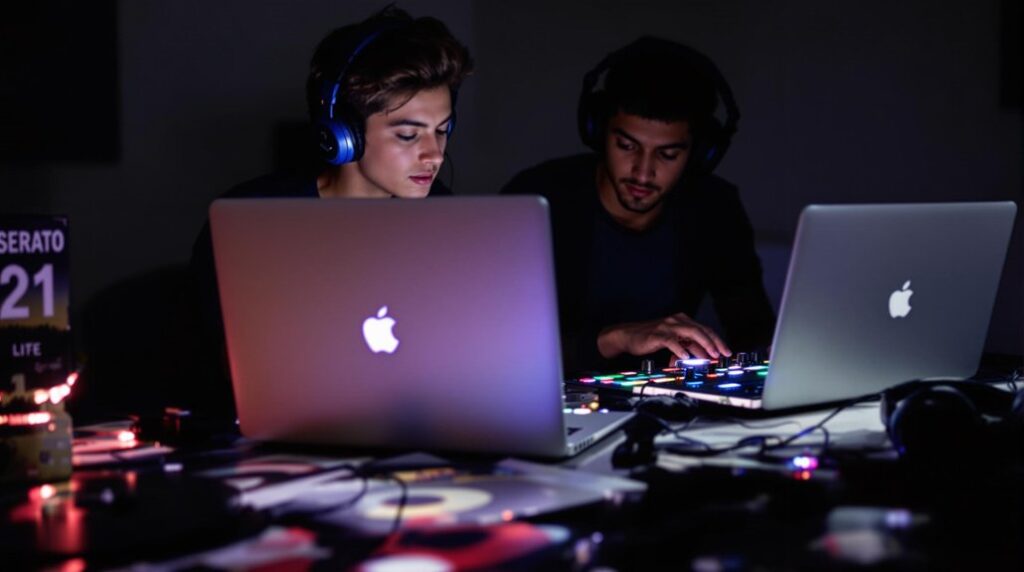Blending tracks seamlessly involves aligning BPMs and mastering beatmatching techniques using tempo and pitch control. Utilize harmonic mixing with compatible keys for a cohesive sound. Manipulate EQ and effects like reverb or delay to guarantee smooth shifts while maintaining tonal balance. Employ creative techniques such as phrase mixing and looping to enhance anticipation. Engaging the audience requires effective energy management. Discover how expert manipulation and innovative strategies lead to an enthralling auditory journey, elevating musical expression.
Key Takeaways
- Align BPMs within a 3-5 BPM range for fluid track transitions.
- Utilize harmonic mixing to ensure sonically cohesive blends.
- Manipulate EQ settings to maintain tonal balance and clarity.
- Employ beatmatching techniques using tempo and pitch control.
- Implement creative mixing strategies like phrase mixing and cue points.
Understanding Track Selection
Track selection is a foundational element in the art of mixing music, requiring both technical acumen and creative intuition. Effective track selection hinges on aligning BPMs, typically within a 3-5 BPM range, to maintain fluid energy and enable seamless shifts. A DJ's prowess is further exhibited through harmonic mixing, selecting tracks in compatible keys to guarantee a sonically cohesive mix. Understanding song structure is critical to executing shifts that feel natural and unforced. A robust music library amplifies DJ skills by offering diverse tracks, facilitating innovative combinations. By analyzing mood and energy levels, DJs craft mixes with an engaging flow, captivating the audience from start to finish. Additionally, knowledge of tempo and rhythm maintains dynamic and engaging set flow, ensuring the audience remains energized and connected to the performance. Masterful track selection remains integral to the mixing process, reflecting both technical precision and artistic flair.
Analyzing Song Structure
Building on the foundation of track selection, analyzing song structure becomes a fundamental skill for any DJ aiming to create seamless and engaging mixes. A typical song structure includes intro, verse, chorus, breakdown, bridge, and outro. In electronic music, build-up and drop sections are prevalent. Each phrase, spanning 8 to 16 bars, dictates shift timing. Identifying phrases and counting beats in a 4/4 time signature allows DJs to pinpoint where sections begin and end, essential for seamless mixing. Understanding the basics of music theory helps DJs anticipate and manipulate energy levels, contributing to the creation of more dynamic and cohesive sets.
Mastering Beatmatching Techniques
Mastering beatmatching requires precise alignment of beats and adept manipulation of tempo and pitch control. DJs employ techniques such as pitch shifting and time stretching to synchronize tracks to a unified BPM, utilizing tools like master tempo to maintain musical integrity during shifts. This skill, rooted in the legacy of early DJ innovators, remains essential for seamless, rhythmic mixing in both digital and analog environments. DJs often use jog wheels for precision in aligning beats and achieving smooth transitions between tracks.
Aligning Beats Perfectly
Achieving impeccable beat alignment is a cornerstone skill for any DJ seeking to master the art of beatmatching. This technique guarantees a seamless conversion by synchronizing the tempo and beats of two tracks.
DJs utilize headphones to cue the incoming track, precisely adjusting its BPM before merging it with the currently playing song. Advanced DJ software and audio editing software are instrumental, providing features like pitch shifting and time stretching for harmonic mixing, allowing tempo adjustments without altering pitch.
Visual aids, such as waveforms, serve as vital conversion techniques, offering clarity on when to initiate the mix. Mastery of beatmatching across diverse genres not only enhances a DJ's mixing music repertoire but also raises audience engagement through flawless execution.
Tempo and Pitch Control
While the art of beatmatching hinges on seamless changes, mastering tempo and pitch control involves a sophisticated interplay of technology and technique.
Beatmatching requires synchronizing the BPM of tracks, which modern DJ software facilitates through precise tempo and pitch control. DJ software empowers users to execute harmonic mixing by independently adjusting tempo and pitch, maintaining musical compatibility.
Time-stretching and pitch-shifting techniques align beats without altering the track's key, ensuring fluid shifts. Monitoring through headphones, gain control, and strategic pitch adjustments are essential to sync tracks before shifts.
The master tempo feature preserves the original pitch during tempo alterations, enhancing musical integrity. This advanced manipulation of audio enables DJs to craft seamless and harmonious auditory experiences, elevating their mixing prowess.
Utilizing EQ and Effects
In the domain of music mixing, precise EQ manipulation is pivotal for achieving tonal balance, enabling the DJ to seamlessly integrate bass, midrange, and treble frequencies without clashing. By strategically reducing bass frequencies during track shifts, one can maintain clarity and prevent auditory muddiness. Furthermore, the creative application of effects like reverb, delay, and filters can not only enhance the smoothness of shifts but also infuse a mix with unique depth and texture, elevating the overall auditory experience. For optimal results, use high-pass filters to remove unnecessary low frequencies and define the overall frequency range.
Controlling Tonal Balance
Controlling tonal balance in a DJ set is essential for crafting a cohesive auditory experience, and this process heavily relies on the strategic use of EQ and effects.
By adjusting EQ, DJs can fine-tune bass frequencies to prevent clashes, ensuring a seamless shift between tracks. High-pass filters are employed to eliminate low frequencies, maintaining clarity and enhancing sound quality.
Effects like reverb and delay are skillfully applied to augment the spatial dimension, enriching the mix. These tools empower DJs to adapt dynamically during performances, addressing both the crowd's energy and the venue's acoustics.
- Feel the energy: Adjust EQ settings live to match the crowd's vibe.
- Clarity matters: Use high-pass filters for cleaner shifts.
- Spatial magic: Apply reverb and delay for richer soundscapes.
- Seamless artistry: Blend tracks with precision for uninterrupted flow.
Enhancing Transition Smoothness
Building upon the mastery of tonal balance, DJs further refine their craft by focusing on enhancing the smoothness of shifts between tracks through adept manipulation of EQ and effects.
Effective EQ usage involves meticulous adjustment of frequency levels, particularly attenuating bass frequencies from the incoming track to guarantee seamless blending.
Shift smoothness is heightened by employing filters, which gradually introduce or subtract frequencies, crafting an organic soundscape.
Effects such as reverb and delay are strategically utilized, adding depth and masking abrupt changes, fostering a cohesive auditory experience.
Dynamic EQ adjustments allow DJs to adapt shifts in real-time, responding to crowd energy while maintaining an integrated sound.
Through practice, DJs innovate with effects and EQ settings, creating a signature auditory journey.
Applying Creative Effects
A myriad of creative effects await DJs seeking to enhance their mixes beyond the ordinary, employing EQ and effects with surgical precision.
Effective EQ changes balance tonal elements, adjusting bass, midrange, and treble to prevent clashing sounds between tracks, resulting in a cleaner mix.
Applying effects requires consideration of the track's energy and structure, ensuring enhancements without muddiness. High-pass filters during shifts eliminate clashing bass frequencies, while automation offers dynamic control, crafting smooth shifts that captivate listeners.
- Revolutionize your mixes with dynamic EQ automation
- Craft unique textures with sparing use of flanging and phasing
- Enhance shifts with high-pass filters for cleaner mixes
- Maintain track integrity through judicious creative effects application
Harnessing these techniques, DJs can raise their craft to new auditory heights.
Transitioning Between Tracks
When shifting between tracks, understanding the underlying song structure is paramount to executing seamless shifts, whether opting for a sharp cut from chorus to verse or a fluid fade in genres like house music.
Shifting between tracks requires adept DJ transition techniques, where similar BPMs are essential for effective beatmatching. This guarantees both tracks are synchronized, maintaining consistent energy on the dancefloor.
Precise EQ adjustments, such as reducing bass on the incoming track, prevent frequency clashing. Cue points strategically set at phrase beginnings and ends enhance shift timing, vital for a seamless blend.
Utilizing harmonic mixing principles can further ensure fluid blending when transitioning between tracks with complementary keys. Additionally, looping sections can be employed to craft dynamic build-ups, enriching the auditory experience. Mastery of these elements fosters a professional and engaging musical journey.
Exploring Creative Mixing Techniques
While mastering traditional mixing techniques is essential for any DJ, exploring creative mixing techniques can enhance a performance to new levels of artistry and innovation. Phrase mixing leverages the structural nuances of tracks, enabling seamless shifts that sustain energy from one dance music track to another. Power block mixing involves rapidly mixing two or more tracks, focusing on harmonic compatibility to create a unique auditory experience. Looping can be utilized to extend compelling sections, crafting anticipation before shifts. Stem separation offers DJs the ability to isolate and layer elements, encouraging improvisation in live performances. Mastering cue point strategies allows DJs to navigate tracks with precision, ensuring smoother transitions and maintaining the flow of the set.
- Emotionally resonate with the crowd
- Transform ordinary into extraordinary
- Inject individuality into shifts
- Keep the dance floor electrified
These techniques, when mastered, boost DJ performances to exhilarating echelons.
Refining Your Mixing Skills
Refining one's mixing skills demands a meticulous approach, combining technical precision with creative exploration. Mastering DJ mixing involves regular beatmatching practice, ensuring seamless shifts by aligning BPMs. Harmonic mixing enhances cohesion, selecting tracks in compatible keys. Experimenting with mixing techniques—fast cuts, long fades, and EQ adjustments—unveils the perfect tonal balance. An essential part of mixing is energy management in mixing, which involves assessing and matching the energy levels of tracks for smooth shifts and maintaining audience engagement. Analyzing performances from veteran DJs provides insight into effective build-ups, drops, and shifts, further refining mixing abilities. Recording and evaluating personal mixes allows DJs to develop a unique style, identifying areas for improvement.
| Technique | Benefit |
|---|---|
| Beatmatching | Seamless shifts |
| Harmonic Mixing | Smooth mix cohesion |
| EQ Adjustments | Tonal quality enhancement |
| Performance Analysis | Style refinement and insights |
These elements collectively forge a path to a refined mixing craft.
Exporting and Sharing Your Mix
After meticulously crafting a mix, the final step is to export and share it with the world, solidifying the DJ's connection with their audience.
DJ.Studio offers seamless exporting capabilities, ensuring mixes are ready in high-quality formats like MP3, WAV, and even video. This flexibility caters to various platforms, from SoundCloud to Mixcloud, and social media, maintaining audio integrity and delivering a professional sound.
DJs can also export their mixes as Ableton Live project files for further refinement. Virtual DJ ranks as the #1 most popular DJ software, known for its extensive features and flexibility, making it a go-to option for mixing and sharing tracks.
Sharing these sonic masterpieces evokes emotion:
- Joy: Watching your audience groove to your beats.
- Pride: Knowing your mix stands out with high-quality sound.
- Excitement: Reaching new listeners across diverse platforms.
- Satisfaction: Delivering a flawless auditory experience.
These elements fortify the DJ's creative journey.
Frequently Asked Questions
How to Mix Songs Seamlessly?
Achieving seamless song mixing involves mastering beat matching, rhythmic alignment, and harmonic mixing. Employ frequency balancing, EQ adjustments, and volume control to maintain clarity. Creative shifts hinge on understanding song structure and executing precise tempo changes for fluidity.
How to Make Songs Seamlessly Transition?
Achieving seamless song changes involves beat matching, key compatibility, and precise tempo adjustments. Mastery of volume levels and EQ techniques enhances fluidity. Change effects, genre fusion, rhythm synchronization, and audio layering collectively guarantee professional, creative integration in musical changes.
How Do You Blend Tracks Together?
Incorporating beat matching and tempo adjustment guarantees smooth integration of tracks. Volume control, EQ settings, and effects usage refine tonal balance. Layering techniques, key compatibility, and understanding song structure enhance changes, while varied transition styles maintain auditory continuity.
How to Smoothly Transition Music?
To smoothly shift music, one must utilize beat matching for consistent tempo changes, make volume adjustments for dynamic range control, guarantee key compatibility, and employ audio effects and crossfading techniques to maintain rhythmic patterns and effective track layering.
Conclusion
In the domain of music mixing, proficiency requires an intricate balance of technical acumen and creative flair. Mastering track selection involves understanding the nuances of song structure, while beatmatching demands precision. Employing EQ and effects strategically can enhance shifts, crafting a seamless auditory journey. By exploring innovative mixing techniques and persistently honing skills, one can achieve a professional polish. Ultimately, exporting and sharing a mix becomes the culmination of artistry and technical prowess in the DJ's craft.




